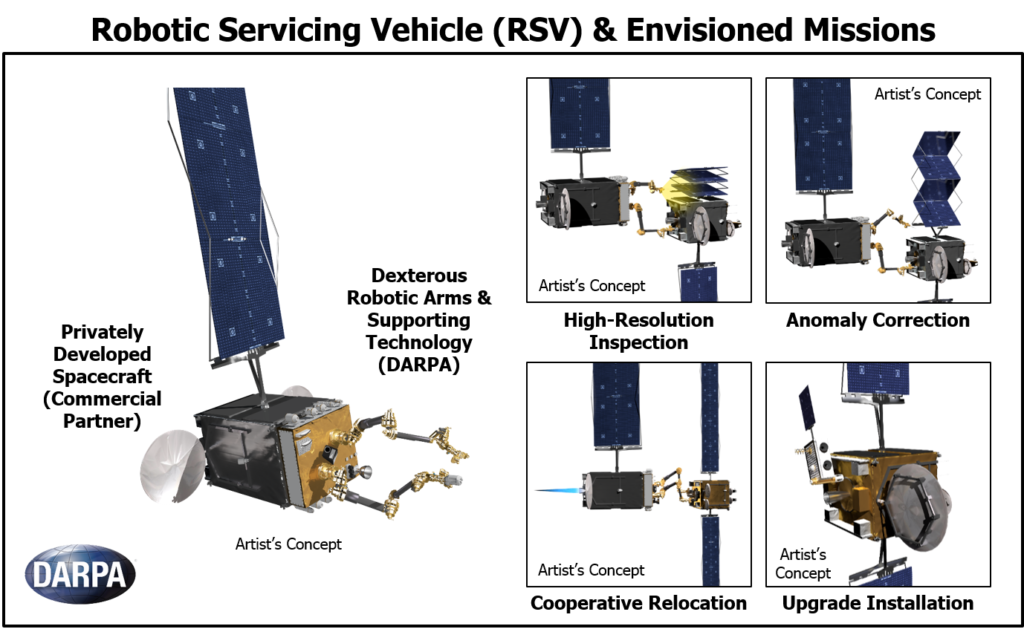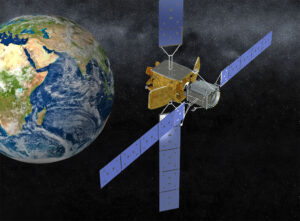 WASHINGTON: DARPA will announce a new partner to replace Maxar Technologies for its robotic servicing spacecraft program “sometime before the end of the year,” says program manager Joe Parrish. DARPA is looking at a launch date in 2022.
WASHINGTON: DARPA will announce a new partner to replace Maxar Technologies for its robotic servicing spacecraft program “sometime before the end of the year,” says program manager Joe Parrish. DARPA is looking at a launch date in 2022.
“We’ve every good reason for optimism,” he told the 2019 Global Satellite Servicing Forum on Tuesday.
The DARPA effort, called Robotic Servicing of Geosynchronous Satellites (RSGS), is designed to create operational capability for “dexterous” robotic repair in space to increase the resiliency of the US satellite architecture. RSGS will be “a first concrete step toward a transformed space architecture with revolutionary capabilities,” he said.
The project got off to a bad start. DARPA awarded the original RSGS contract to Space Systems Loral (now part of Maxar Technologies) in February 2017, at which point Orbital ATK (now part of Northrop Grumman) sued on grounds that DARPA was violating US government policy by competing directly with its own planned servicing vehicle, called the Mission Extension Vehicle (MEV). Orbital’s lawsuit was thrown out in July 2017.
This January, Maxar abruptly dropped out of the program, citing financial issues. Under the program, DARPA’s industry partner is expected to carry part of the costs, in particular those related to providing the satellite bus. Parrish said the idea is to use a “heritage” bus (sort of the satellite’s chassis) that requires a minimum amount of tweaking for it to accommodate the robotic arm and its attendant equipment.
The first of the RSGS payload packages (which include a robotic arm, a camera, and other electronics) will be delivered next month; the second in December, Parrish told the two-day forum sponsored by the Consortium for Execution of Rendezvous & Servicing Operations (CONFERS). The Naval Research Laboratory, which designed the robotic arm, will be charged with integrating the payload into the spacecraft bus.
Parrish stressed that the program still intends to transfer ownership of the finished system to the chosen commercial partner — who can then market the RSGS capability to both US government and commercial customers in need of on-orbit services. According to Parrish, the RSGS can provide four types of service: inspection of anomalies that appear in a satellite’s operations; assist with adjustments to a satellite’s orbit; correct mechanical problems; and, cooperatively install new payloads to upgrade capabilities.
According to DARPA’s RSGS fact sheet, the agency also wants to see the program evolve into “a servicer spacecraft with sufficient propellant and payload robustness to enable dozens of missions over several years.”
Meanwhile, Orbital’s MEV program — now part of Northrop Grumman’s SpaceLogistics subsidiary — is set for first launch in a few weeks, following a delay from Sept. 30. The launch of the MEV-1 will ensure that SpaceLogistics is the first company to be able to market on-orbit services for commercial customers, Joe Anderson, SpaceLogistics vice president for operations and business development, told the forum.

Northrop Grumman SpaceLogistics’ MEV-1 will launch soon
MEV-1’s first “client satellite” is Intelsat 901. The mission, Anderson explained, will involve docking with the Intelsat bird in the so-called graveyard orbit above GEO (some 36,000km above sea level). The MEV-1 then will provide the satellite with electronic propulsion power so it can push itself back into GEO and extend its life by an impressive five years. The MEV-1 spacecraft has a 15-year lifespan so it could potentially be moved to service another GEO satellite after completing its first mission.
DoD too is interested in satellite servicing, and the MEV in particular. DoD’s Space Enterprise Consortium granted SpaceLogistics a feasibility study contract in July to evaluate servicing of four national security satellites, said Joshua Davis of the Aerospace Corporation. The idea, he told the forum on Tuesday, is for DoD to eventually buy on-orbit servicing from a commercial company instead of building its own spacecraft.
The Space Enterprise Consortium is an arm of the Air Force Space and Missile Systems Center (SMC), headquartered at Los Angeles AFB in California, that uses Other Transaction Authority to rapidly develop prototypes, according to an SMC fact sheet. The consortium in June added its 300th industry partner. As first reported by colleague Sandra Erwin of Space News, SMC recently opened a competition for improved cybersecurity.
In a ‘world first,’ DARPA project demonstrates AI dogfighting in real jet
“The potential for machine learning in aviation, whether military or civil, is enormous,” said Air Force Col. James Valpiani. “And these fundamental questions of how do we do it, how do we do it safely, how do we train them, are the questions that we are trying to get after.”


























